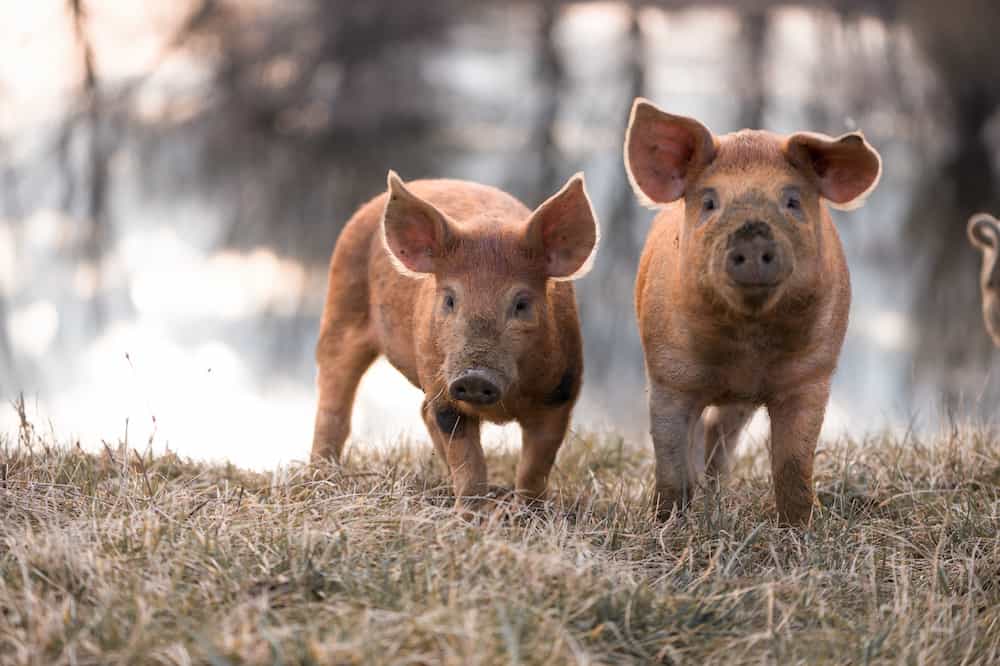Mangalitsa pigs are a heritage breed with an interesting history. They’re known for their tasty meat and distinctive appearance. Consider adding one to your homestead if you’re interested in raising a unique breed
Mangalitsa Pig
To get to know this pig breed better, here’s a brief look into its interesting history.
Early 19th Century
Depending on where you are in the world, Mangalitsa pigs are also known as Mangalica or Mangalitza. Indigenous to Hungary, their popularity boomed during the 19th century.
Archduke Joseph Anton Johanna received Sumadija pigs as a gift during the Austro-Hungarian Empire. A few years passed, and he decided to breed his pigs with Szalonta and Bakony pigs, resulting in a new breed.
The Mangalitsa is different from others, distinct for their curly hair, and is often referred to as hairy pigs. Their popularity continued to grow until their breed became official in 1927.
1927 to 1950
There were plenty of notable figures that owned them, including Emperor Franz Josef I of Austria, who is said to have had three million.
You would also find that they would bring in significant earnings for farmers at pig fairs, primarily until the 1950s. One of their most notable characteristics was their ability to produce excessive amounts of fat.
Homesteaders would use the lard for several things, ranging from cooking to cosmetics. Some individuals even used pig fat for explosives and industrial lubricants.
During World War II, the number of Mangalitsa pigs significantly reduced worldwide, especially with Hungary’s losses. Not only was it relatively impossible for farmers to afford to own the pigs, but their famous lard was also in less demand.
1990 to Present
When more intensified agriculture came into play during the 1970s, raising a herd of Mangalitsa became more challenging.
They were more time-consuming to care for than more modern pig breeds, and they took up too much space on farms.
Many farmers also found that they produced far fewer piglets, and traditional farming became less popular.
As early as 1990, there were fewer than 200 of these pigs worldwide; today, there are over 50,000. You can even find notable organizations dedicated to preserving the breed, as they came so close to being considered endangered. In Hungary, you will find they are popular to raise.
Another interesting fact is that researchers may have found a link suggesting they are a direct relative of the wild boar.
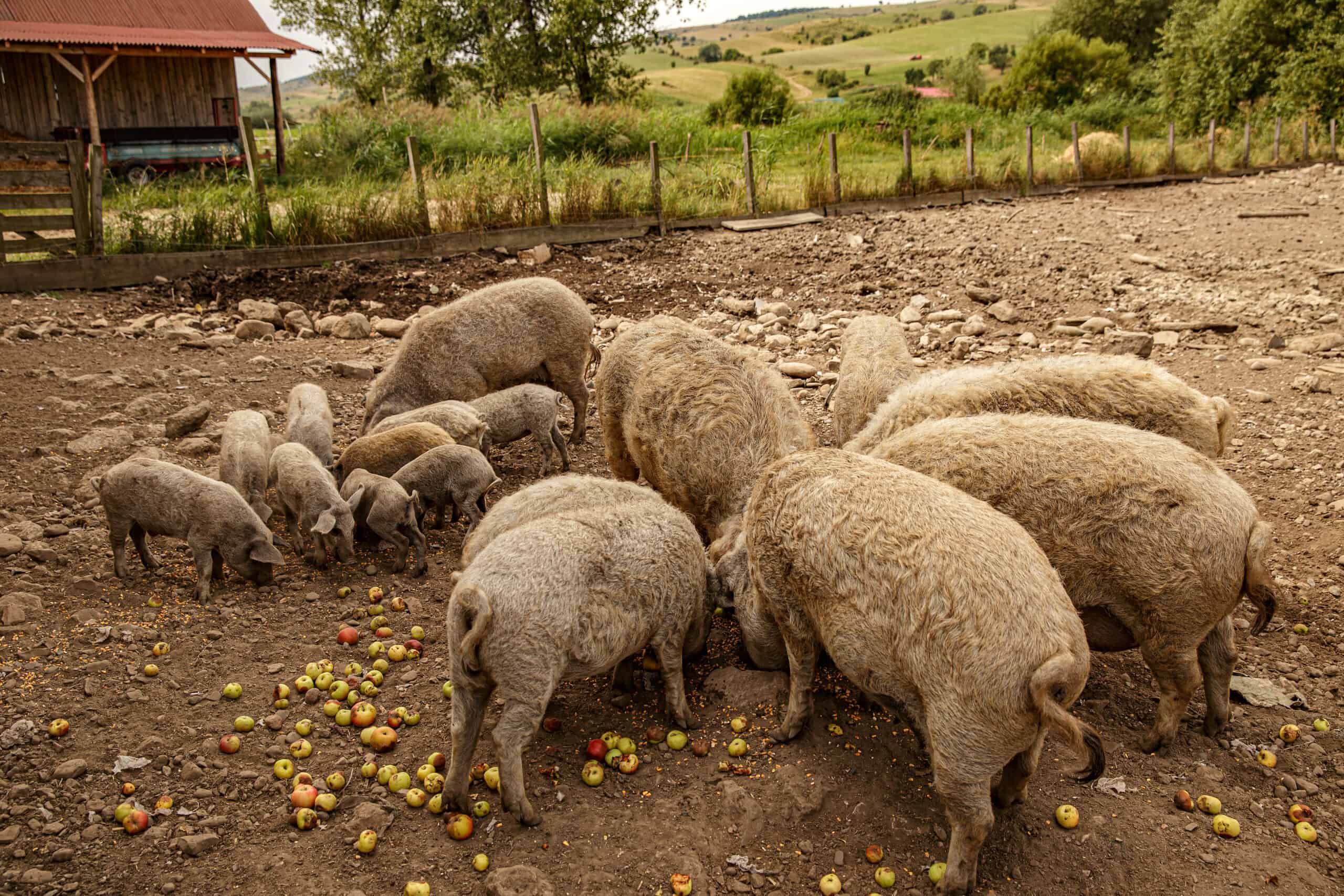
What Is Most Unique About a Mangalitsa Pig?
Mangalitsa pigs are known for their thick layer of fat, a distinctive characteristic of the breed.
Mangalitsa pig fat is said to melt in your mouth, making it a phenomenal addition to meals. Its meat is also unique in that many refer to it as the “Kobe beef of the pig world.”
You’ll often find that homesteaders refer to these pigs as the fattiest in the world. On average, their total body weight accounts for 60% to 70% fat and up to 35% lean meat.
To compare, most modern pig breeds have up to 50% fat.
How Big Do Mangalitsa Pigs Get?
These pigs require a lot of care and attention to grow to their fullest potential. In fact, many farms stopped breeding them because they don’t grow as quickly as other pig breeds.
So, how big do Mangalitsa pigs get, really? With proper care, they can grow as large as 400 pounds, if not larger.
As with any other animal on your farm, their size will depend on their health and diet. Mangalitsa pigs are foragers, which means they will require plenty of space on your farm to peruse through fields.
You will also need to provide them with extra bulking materials, such as corn, barley, and wheat.
Over 2 years, you can quickly increase your pig’s weight to just under 800 pounds at finishing weight, which offers a substantial amount of meat.
For homesteaders, raising Mangalitsa pigs can be substantially different than the other animals you own.
Instead of needing to prepare plenty of space for meat, you’ll need plenty of room for dealing with fat. Remember, some animals can contain up to 70% fat out of 400 pounds of body weight.
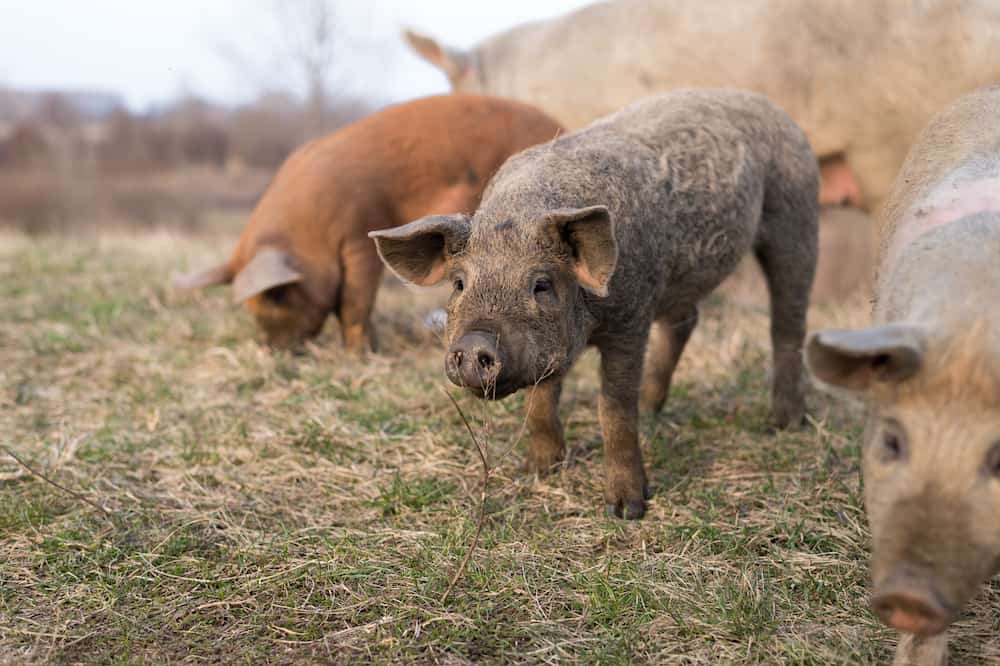
Mangalitsa Pork is Known for Its Unique Flavor & Marbling
Pork is the most widely consumed meat in the United States, and you’ll find that Mangalitsa is delicious. Sandwiched between layers of supple fat, the meat creates a melt-in-your-mouth texture you won’t soon forget.
Many people ask, are Mangalitsa pigs good for eating? Definitely! Not only can you make savory meals, but you can also use it for baking, such as lard used for pastries. (Another lard pig breed to consider are Berkshire pigs.)
More families are purchasing Mangalitsa pig meat in smaller cuts, such as roasts, hams, bacon, and chops. You can also find a substantial number of more massive cuts, including hind legs and whole shoulders.
Even the back fat can be put to fair use.
Beyond meals, the lard in these pigs is in such excess that you can use it across several industries. Overall, it’s one of the most multi-purpose animals that you can introduce to your homestead. Another meat breed to consider is the Hampshire pig.
Are Mangalitsa Pigs Good for Eating?
When you work with Mangalitsa pork, you’ll find that it has an exceptionally dark red color with beautiful marbling.
Eating Mangalitsa pork has a noticeable difference compared to modern breeds, too. The creamy white fat helps to soothe the meat to a gentle and soft texture.
You’ll also find that it has a more pork-forward flavoring, likely due to their natural diet of barley, corn, wheat, and forage.
Why Is Mangalitsa Pork So Expensive?
The main factor that influences the cost of Mangalitsa pork is the environment they are raised in.
Farmers have to spend a lot more of their time nurturing these animals to reach their full potential. With that said, the more time required, the more expensive the meat will become.
A few factors that go into determining the price of Mangalitsa pig meat include:
Living Conditions
Mangalitsa pigs don’t do well with modern-day farming techniques, as they are innately meant to roam. Farmers will have to allocate a significant chunk of their property to these hogs to have freedom.
Because they need a large piece of land, farmers are bound to increase their by-products’ prices.
Flavor and Demand
Anything that tastes good or is recognized as the best of something is going to cost more. Mangalitsa pork is commonly referred to as the best-tasting pork in the world, which means it’s going to have a higher price.
Not only is the meat’s texture different from any other pork you’ve experienced, but its flavor is also unique
Strict Breeding Standards
Unlike factory-bred hogs, these pigs require special raising techniques and more focus. These standards undoubtedly represent a significant chunk of the cost.
Life Cycle
Above all else, these hogs’ life cycle is another reason why is Mangalitsa pork so expensive. As farmers can’t turn around and profit immediately, the meat is bound to be more expensive.
Factory-bred pigs will go through their life cycle quite quickly, while Mangalitsa pigs don’t. They require years of optimization, and their slower growth rate ensures their meat and fat is of a higher quality.
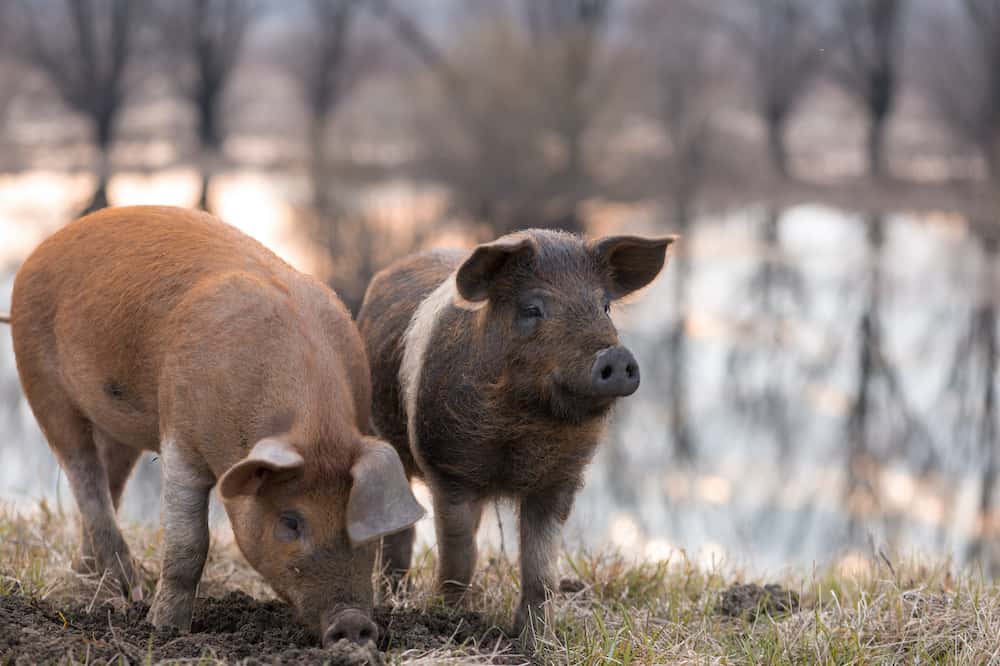
Pros and Cons of Raising Mangalitsa Pigs
Now that you’re aware of Mangalitsa hogs’ history and quality of meat, let’s get into the pros and cons of raising them and whether they are livestock to consider.
Pros of raising a Mangalitsa pig
Compared to other big breeds, you’ll find that raising Mangalitsas offers a long list of advantages and benefits.
- Mild Temperament
One of the most significant advantages of owning Mangalitsa pigs is that they have a mild temperament.
In fact, it’s so mild that children can assist with raising and maintaining them over the years. They are quite friendly and will make a wonderful addition to pig breeds currently at your homestead.
- Make Unique Pets
Did you know that some homesteaders opt to own a Mangalitsa pig as a pet rather than livestock?
They can be a joy to have around your farm with their mild temperaments, especially as piglets. They are available in an assortment of colors, too, which is a significant selling point.
Some farmers have found that with appropriate treatment, these pigs can be just as gentle as dogs.
They’re fun to play with, easy to tame over time, and can become a phenomenal addition to your family. However, they are best suited to be bred for their meat and by-products.
- Foraging Breed
Caring for livestock properly is essential. If you have plenty of space for your animals, this is a significant benefit of these pigs. You’ll want to let them roam freely so that they can enjoy foraging.
- Adaptable and Hardy
It’s important to remember the first generations of Mangalitsas were found in Hungary. As they were exposed to extreme temperatures, they’re one of the hardiest pig breeds. You’ll find that they do exceptionally well in cold and warm climates alike.
- Easy to Raise
Although it can be time-consuming to wait for your pigs to mature, raising them is fairly straightforward.
Cons of raising Mangalitsas hogs
There are plenty of advantages to owning these pigs, especially for homesteaders. However, there are a couple of disadvantages to take note of.
- Consistent Rooters
One of the most considerable warnings of Mangalitsa pigs is that they will tear your property up. They are well-known for their rooting capabilities, which can quickly destroy a farm if they’re not contained.
Although you won’t want to create a small pen, you’ll at least want to limit their foraging area. It can be beneficial if you need a specific area of your property turned over; otherwise, they can be very destructive.
If you are interested in a pig breed that roots less than Mangalitsas, consider raising Kunekune pigs. They graze but aren’t as apt to root.
- Lengthy Growth
Farmers wanting animals that can produce a fast turnaround for meat and by-products won’t want to raise them. Most often, pig owners will find that they have to wait at least 15 months before slaughtering their herd.
- Time Consuming
Because they can take 15 months to mature, it also means you’ll have to allocate a lot of time to maintaining your herd. For example, you can consider supplementing their grass diet with barley for an extended period.
- Challenging to Source
Although Mangalitsas are becoming more popular, they are still a relatively difficult breed to find. This is especially true in North America, as they’re still more popular in Europe.
You’ll not only have to spend a lot of time to find a breeder but one that puts a lot of effort into breeding them.
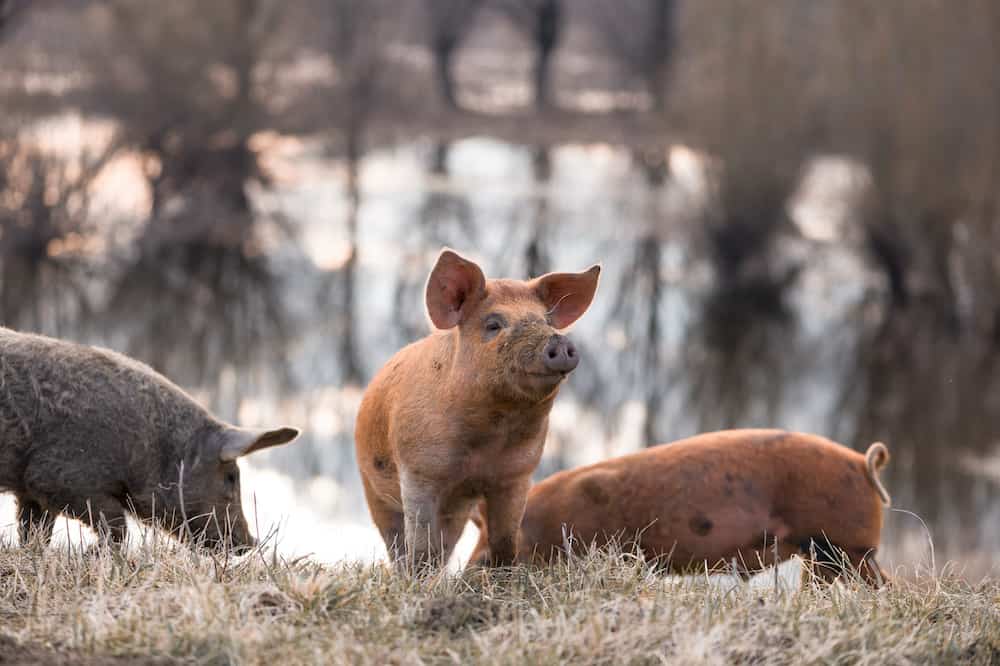
How to Prepare Your Homestead for Mangalitsa Pigs
There are a few essential things to make a note of if you want to introduce Mangalitsas.
Fencing
There is very little need for fencing, especially if you allow your pigs to roam freely. However, to prevent them from tearing up your entire farm, it’s a good idea to put up moderate fencing.
This process allows them to know where they can and cannot go, especially if you opt for electric fencing. Consider predators in your area as well.
Winter Shelter
The majority of homesteaders don’t worry about bringing their Mangalitsas inside, even during the winter. These Hungarian-born pigs are bred to withstand extreme temperatures, and they love staying outside.
Even in the coldest weather, they are bound to thrive, which is why you won’t need a massive barn for them. You can easily house them in a small winter shelter so they can stay warm and dry.
Foraging Area
The most important way to prepare for your new pigs is to make sure you find the perfect foraging area. As they work through the natural materials, you can then replant and allow them to tear the ground up again.
Many farmers find that rotating the pigs from one area to another is the best way to keep their diets well-rounded.
Is Raising Mangalitsa Pigs Worth It?
Deciding whether adding Mangalitsas to your farm is worth it will depend on how quickly you will want to be able to use them for meat. They are slower growing than other pig breeds.
However, with their mild temperament, natural diet, and easy-going nature, they often prove to be a practical family-friendly farm animal to raise.

